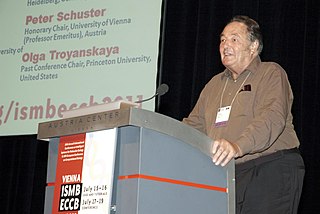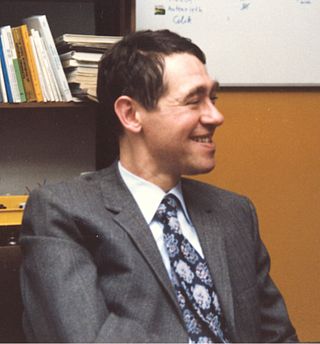
Christiane (Janni) Nüsslein-Volhard is a German developmental biologist and a 1995 Nobel Prize in Physiology or Medicine laureate. She is the only woman from Germany to have received a Nobel Prize in the sciences.

Peter K. Schuster is a theoretical chemist known for his work with the German Nobel Laureate Manfred Eigen in developing the quasispecies model. His work has made great strides in the understanding of viruses and their replication,as well as theoretical mechanisms in the origin of life.

Ernst Otto Fischer was a German chemist who won the Nobel Prize for pioneering work in the area of organometallic chemistry.

The Gottfried Wilhelm Leibniz Prize,in short Leibniz Prize,is awarded by the German Research Foundation to "exceptional scientists and academics for their outstanding achievements in the field of research". Since 1986,up to ten prizes are awarded annually to individuals or research groups working at a research institution in Germany or at a German research institution abroad. It is considered the most important research award in Germany.
Franz-Ulrich Hartl is a German biochemist and Managing Director of the Max Planck Institute of Biochemistry. He is known for his pioneering work in the field of protein-mediated protein folding and is a recipient of the 2011 Lasker Award along with Arthur L. Horwich.

The Liebig Medal was established by the Association of German Chemists in 1903 to celebrate the centenary of Justus von Liebig. Since 1946 it has been awarded by the Society of German Chemists.

Johann Hermann Wolfgang Mulzer is a German organic chemist,best known for his work in total synthesis. Since 1996,he has been a professor of chemistry at the University of Vienna.

Hubert Simon Markl was a German biologist who also served as president of the Max Planck Society from 1996 to 2002.
Bernd Giese is a German chemist and guest professor in chemistry at the University of Fribourg in Fribourg,Switzerland since 2010.
Helmut Schwarz is a German organic chemist. He has been a professor of chemistry at the Technische Universität Berlin since 1978. In 2018,he was elected a foreign associate of the U.S. National Academy of Sciences.
Ilme Schlichting is a German biophysicist.

Petra Schwille is a German professor and a researcher in the area of biophysics. Since 2011,she has been a director of the Department of Cellular and Molecular Biophysics at the Max Planck Institute for Biochemistry in Martinsried,Germany. She is known for her ground-laying work in the field of fluorescence cross-correlation spectroscopy,and numerous contributions on model membranes. Her current research focuses around bottom-up approaches to building an artificial cell within a broader area of synthetic biology. In 2010,Schwille received the Gottfried Wilhelm Leibniz Prize.

Martin Quack is a German physical chemist and spectroscopist;he is a professor at ETH Zürich.

Horst Kessler is a German chemist and Emeritus Professor of Excellence at the Institute for Advanced Study at the Technical University of Munich (TUM). Kessler works in the area of bioorganic chemistry,in particular peptide synthesis,and nuclear magnetic resonance spectroscopy. He also made contributions to magnetic resonance imaging.
Arthur Konnerth is a German neurophysiologist,the Hertie Senior Professor of Neuroscience at the Technical University of Munich.
Ulrich Aloysius Konrad is a German musicologist and professor at the Institute for Music Research of the University of Würzburg. He is considered an expert on European music of the 17th to 20th centuries,especially the works of Mozart,Robert Schumann,Richard Wagner and Richard Strauss. He wrote a biography,Wolfgang AmadéMozart,and studied the composer's sketches.
Otto Ludwig Lange was a German botanist and lichenologist. The focus of his scientific work was on the ecophysiology of wild and cultivated plants as well as lichens. He investigated heat,frost and drought resistance of lichens,bryophytes and vascular plants growing under extreme environmental conditions.
Wolfgang P. Baumeister is a German molecular biologist and biophysicist. His research has been pivotal in the development of Cryoelectron tomography.
Ulrich Hofmann was a German chemist known for his study of clay minerals and the pioneering use of electron microscopes in the study of carbonaceous materials.










